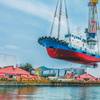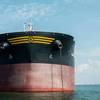Costa Costa Fortuna has taken to the open sea for the first time. Costa Crociere’s new flagship which, with her 105,000 gross tonnage, is the largest cruise ship in the history of Italian seafaring, today left Fincantieri’s Sestri Ponente shipyards, where her fitting out is nearing completion, bound for the builder’s Palermo yard. This crossing will be used to carry out sea trials.
On the way from Genoa to Palermo Costa Fortuna will be subjected to various preliminary operational tests on her systems, equipment and engines. The ship is due in Palermo on 28th August and will stay until 3rd September in Fincantieri’s local dry docks. Here, her bottom will be scrubbed and given a final coat of paint prior to her official sea trials and speed tests.
On 3rd September the Costa Fortuna will set sail once again, heading for Genoa, for a series of official technical sea trials. Testing will end on 6th September, when she is due back at Sestri Ponente.
“We are very proud to see Costa Fortuna set sail from the shipyards in Sestri Ponente, knowing that our flagship is following in the wake of the historic Michelangelo,” said Pier Luigi Foschi, Chairman and Chief Executive Officer of Costa Crociere. “We could not have chosen a more fitting setting than Genoa and the Sestri yards, so rich in history and seafaring tradition, for the debut of our new flagship, the largest cruise ship ever in the history of Italian seafaring. The departure of Costa Fortuna on her round of sea trials marks the latest development in our fleet expansion programme, which is going exceedingly smoothly. Thanks to the arrival of Costa Fortuna and her sister ship Costa Magica, our total fleet capacity will reach 19,000 Guests by 2004.”
“We are particularly proud,” announced Giuseppe Bono, CEO of Fincantieri, “because with this beautiful ship, which in a couple of months will become the flagship of the Costa fleet, we’re consolidating an alliance that goes back to the early 1990s. The quality of our vessels,” Bono went on, “and their punctual delivery are crucial factors in the choice of owners. This is why we trust that our ties with Costa Crociere will grow stronger still in the future.”
Costa Fortuna will enter into service in mid-November 2003 and will be the first large passenger ship to emerge from the shipyards in Sestri Ponente since the Michelangelo in 1965 – the same yard that built the legendary “Rex” (1932), “Andrea Doria” (1951), “Cristoforo Colombo” (1953), “Federico C” (1957) and “Leonardo da Vinci” (1958).
Costa Fortuna is 105,000 gross tonnage, 272 metres in length, 38 metres in breadth and 66 metres high. Her maximum capacity is 3,400 passengers, including 2,716 in lower berths: she is the largest cruise ship built by an Italian yard for an Italian company ever to fly the Italian flag.
The new vessel has a total of 1,358 cabins of which 857 oceanview (63%), including 64 suites, 458 with a large balcony and 335 with a porthole. The ship offers Guests a stunning array of facilities for relaxation and entertainment: 11 bars, 4 restaurants, a theatre on three floors, 3 swimming pools, casino, disco, ballroom, 1,300 m2 of physical wellbeing space comprising 450 m2 of gym space.
The Costa Fortuna is dedicated to the legendary Italian liners that provided regular passenger services between Italy and the Americas.
The public areas on the ship bear the names and the years of entry into service of some of the most famous and elegant Italian ocean liners. For example, the ship’s theatre, which extends over three decks, is named after the Rex launched in 1932, two of the restaurants are called “Ristorante Raffaello 1965” and “Ristorante Michelangelo 1965”, while the main bar is the “Gran Bar Conte di Savoia 1932”.
These historic passenger ships provided inspiration for the American architect Joe Farcus in the styling and design of Costa Fortuna’s public areas. In addition, there will be scale models of some of these transatlantic liners on board. A 6-metre version of the Michelangelo will be exhibited at the entrance to the restaurant of the same name, while a 3-metre model of the Rex built in 1932 will grace the theatre. Other memorabilia from the legendary Italian liners includes copies of posters and advertisements from the time – mainly the 1920s and 1930s – which will be displayed in some of the public areas. For more recent history, on the other hand, just glance up at the ceiling of the main lobby, called “Atrio Costa”, where you will be able to admire 26 two-to-three metre models of all the ships that have been members at one time or another of the Costa fleet: a tribute to the first (and still the leading) Italian cruise company.
The passenger decks of Costa Fortuna are named after some of the European and American ports where Costa’s liners used to make stopovers.
Costa Fortuna is one of two sister ships commissioned by Costa Crociere from Fincantieri, entailing an outlay of approximately one billion euros. Costa Magica, sister ship of the Costa Fortuna, is also currently under construction at the Sestri Ponente shipyards and will enter into service at the end of 2004.
Sponsored Content
MSC Sets a New Standard for Time Off in 2025, Plus Earn a $38,340 Bonus as an Able Seaman!

Navigate Compliance with Confidence: Discover Carbon Diligence from ABS Wavesight

Featured videos

Xenos Marine Takes Aim at the Gulf Salvage, Decommissioning Markets

AI to the Rescue: Zelim’s ZOE to be Installed on Cruise Ship
April 2025
 Read the Magazine
Read the Magazine

 Read the Magazine
Read the Magazine
This issue sponsored by:

Looking Back: U.S. Maritime Industry Steps Up in Wake of FSK Bridge Collapse
Subscribe for
Maritime Reporter E-News
Maritime Reporter E-News is the maritime industry's largest circulation and most authoritative ENews Service, delivered to your Email five times per week









